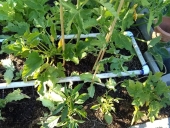


Rocket Mass Heater Plans: Annex 6" L-shaped Bench by Ernie and Erica
will be released to subscribers in:
soon!



















[img]http://i109.photobucket.com/albums/n52/havlik1/permie%20pics2/permiepotrait3pdd.jpg[/img]
"One cannot help an involuntary process. The point is not to disturb it. - Dr. Michel Odent
















strawdog wrote:
Market garden: Because it would be ethical to grow organic food locally for people. It is harder work, more exspensive, and would require water, also composting and not using the land naturally.
"the qualities of these bacteria, like the heat of the sun, electricity, or the qualities of metals, are part of the storehouse of knowledge of all men. They are manifestations of the laws of nature, free to all men and reserved exclusively to none." SCOTUS, Funk Bros. Seed Co. v. Kale Inoculant Co.




we are not in the flood zone, but two blocks down is.
If I dig the soil in high summer (mid August) the soil gets moist after about 2-3ft.




Brenda
Bloom where you are planted.
http://restfultrailsfoodforestgarden.blogspot.com/








Brenda
Bloom where you are planted.
http://restfultrailsfoodforestgarden.blogspot.com/
















Brenda
Bloom where you are planted.
http://restfultrailsfoodforestgarden.blogspot.com/




[img]http://i109.photobucket.com/albums/n52/havlik1/permie%20pics2/permiepotrait3pdd.jpg[/img]
"One cannot help an involuntary process. The point is not to disturb it. - Dr. Michel Odent




Brenda
Bloom where you are planted.
http://restfultrailsfoodforestgarden.blogspot.com/




Rainfall: 8.8' average per year: 50% between February and June. Driest month: July
Snowfall: 13.6' average per year: Between November and April (January being the snowiest)
Growing Season: 290 days average sunshine. (Hot summers, Cold winters)




Brenda
Bloom where you are planted.
http://restfultrailsfoodforestgarden.blogspot.com/




Soil EffectsSoil Effects
The role that soil texture plays in the dissipation of the autotoxic chemical has only recently been studied. In our research, extracts made from alfalfa topgrowth containing the autotoxic chemical passed more rapidly through leaching columns of sandy soil than through columns containing silty clay loam (Jennings and Nelson, 1998). Fractions of the leachate that passed through the columns were collected and added to petri dishes containing alfalfa seeds. Percent germination and root growth were measured after three days. Approximately fifty percent more water was required to move the extracts through the silty clay loam compared to the sandy soil. The autotoxic effect on root growth was stronger (reduced root growth more) in the sandy soil, but persisted longer for the silty clay loam.
This suggests that in the short term autotoxicity may be more severe in sandy soils, however, with irrigation the autotoxic factor may be leached out of the root zone more easily in sandy soils than in soils of heavier texture. This practice has been used successfully in Kansas and Nebraska where sandy fields are irrigated heavily after killing the old alfalfa, but before planting the new stand (J. Schafer, 1991, personal communication; B.A. Anderson, 1995, personal communication). Further research is needed to determine the amount of rainfall or irrigation needed for different soil textures to allow shortened rotation intervals.
"the qualities of these bacteria, like the heat of the sun, electricity, or the qualities of metals, are part of the storehouse of knowledge of all men. They are manifestations of the laws of nature, free to all men and reserved exclusively to none." SCOTUS, Funk Bros. Seed Co. v. Kale Inoculant Co.





|
I found some pretty shells, some sea glass and this lovely tiny ad:
Freaky Cheap Heat - 2 hour movie - HD streaming
https://permies.com/wiki/238453/Freaky-Cheap-Heat-hour-movie
|



